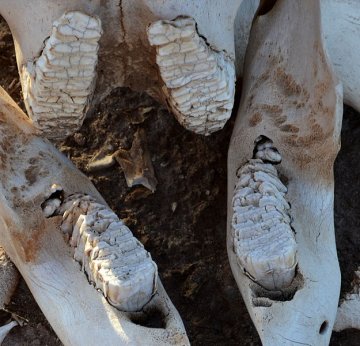Elephant Teeth
Elephants have the biggest teeth of any other mammal in the world. Normally, an elephant has 26 teeth, which includes incisors (also known as tusks), 12 molars, and 12 deciduous premolars.
Shape of Elephant Teeth
For African elephants, the teeth are loxodont, which means that they have a sloping shape to them. As for Asian elephant teeth, they have a compressed diamond-shaped lamella profile that is adapted to the animal’s diet of shrubs, grasses, and bark. The teeth work by working in a forward and backward motion which serves to grind down the plant material for easier swallowing and digestion.
The Tusks as Teeth
The tusks are modified incisors located in the elephant’s upper jaw. The tusks replace deciduous milk teeth when the animal turns between 6 and 12 months old. After this, they continue to grow at about 17 cm each year. Just like humans, elephants are in most cases either right or left-tusked.
The master tusk is normally more worn down and is shorter with a rounded tip. African elephants have tusks in both males and females with the same length, but the tusks on the males are generally thicker. In Asian elephants, only the males have large tusks while the females have very small ones or no tusks at all.
Teeth Development in Elephants
The dentition of elephant teeth is unique, unlike most animals, including humans whose teeth are produced from top to bottom of the mouth. The elephant’s teeth are developed from back and they push forward. Basically, an elephant has six sets of molars during their lifetime and as each tooth wears out through grinding, another tooth replaces it.
At the time of birth, a baby elephant has four small molars. The calf will lose these molars when it is two years old. Each successive set of teeth lasts longer than the previous set until the elephant turns 30 years old, which is when the final set appears.
The second set of teeth falls out when the elephant is between four and six years old, and the third set is lost between nine and 15 years of age. The fourth set lasts until the elephant reaches between 18 and 28 years old. The worn out elephant teeth will wear off into a shelf which will eventually break off and fall out.
The leading cause of death among mature elephants is their teeth; as the final molar starts to break down, it becomes very difficult for the animal to chew and digest food. The elephant eventually dies of starvation.

